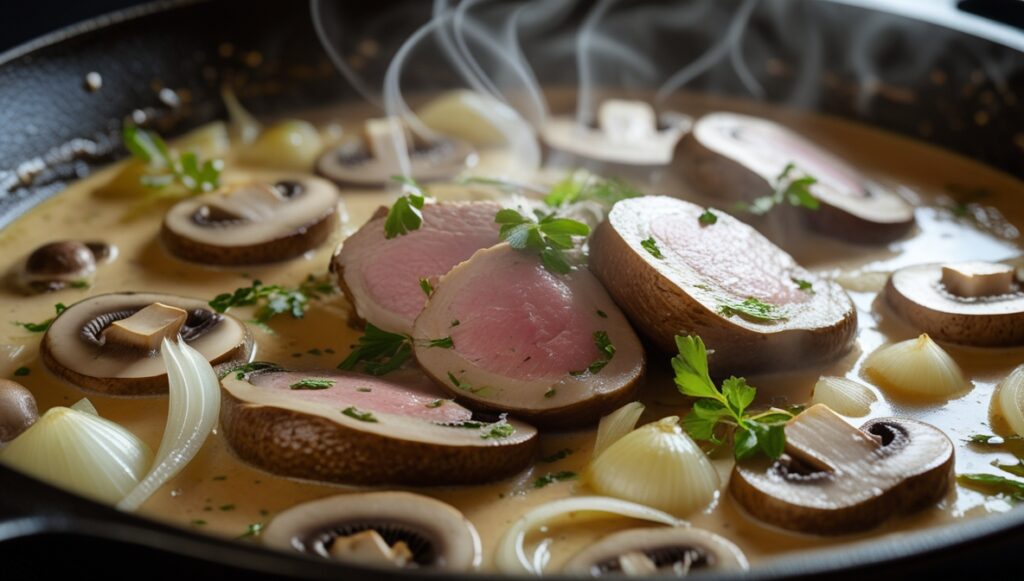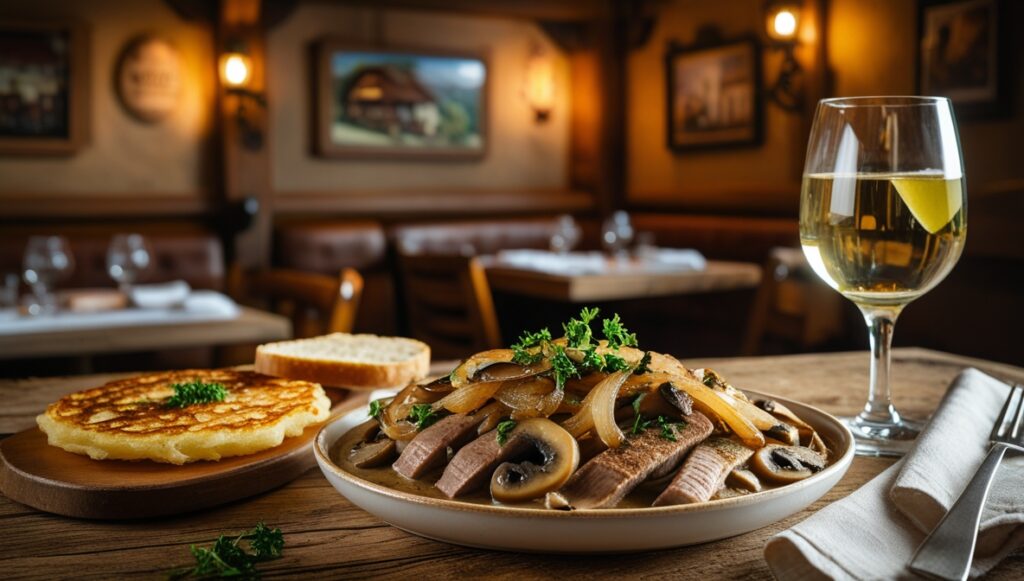Introduction
Zürcher Geschnetzeltes, or “sliced meat Zurich style,” is one of Switzerland’s most beloved dishes. Originating from the German-speaking region, this creamy veal dish captures the essence of Traditional Switzerland Food. Its tender meat, velvety mushroom sauce, and subtle seasoning make it a timeless favorite among locals and tourists alike.
Why is this dish so popular? It strikes a perfect balance between richness and refinement. Easy to fall in love with, it’s often served during family gatherings, Sunday lunches, and festive occasions, making it both a cultural staple and a culinary indulgence.


History & Cultural Significance
Zürcher Geschnetzeltes first appeared in cookbooks in the mid-20th century but is believed to have been a cherished home recipe long before. Hailing from Zurich, it reflects the Swiss tradition of making the most of quality local ingredients like dairy and meat.
Unlike many European dishes with royal connections, Zürcher Geschnetzeltes grew in popularity through households and local restaurants rather than palaces. It embodies the Swiss values of precision, simplicity, and flavor. Today, it is often featured in culinary festivals celebrating regional dishes.
Ingredients & Regional Variations
Key Ingredients:
Veal (thinly sliced)
Onions
White wine
Cream
Butter
Mushrooms
Lemon juice
Flour (for thickening)
Regional Variations:
Luzern version: Sometimes includes pork instead of veal.
Bernese twist: Incorporates herbs like thyme or rosemary.
Modern adaptations: Vegetarian versions with mushrooms or tofu, and dairy-free versions using plant-based creams.
Cooking Process & Difficulty Level

Difficulty: Beginner-friendly with some attention to detail.
Cooking Steps:
Lightly season and sear veal slices in butter. Set aside.
Sauté onions and mushrooms until golden.
Deglaze with white wine and add cream.
Return veal to the pan and simmer gently.
Adjust seasoning, add a splash of lemon juice, and serve hot.
Tip: Do not overcook the veal to keep it tender.
Where to Eat Zürcher Geschnetzeltes in Switzerland
Top Restaurants:
Kronenhalle, Zurich – A historic venue with exquisite Zürcher Geschnetzeltes.
Zeughauskeller, Zurich – Traditional Swiss fare in a lively setting.
Gasthof Hirschen, Eglisau – A local favorite for authentic flavors.
Restaurant Didi’s Frieden, Zurich – Modern presentation with classic taste.
Pairing with Drinks & Side Dishes
Drinks:
Dry white wine (like a Swiss Chasselas or Pinot Blanc)
Sparkling mineral water
Light lager or pilsner beer
Side Dishes:
Rösti (crispy grated potatoes)
Buttered noodles
Seasonal vegetables (like asparagus or green beans)
Fun Facts & Lesser-Known Trivia
Despite its popularity, Zürcher Geschnetzeltes only became widely recognized in Swiss cuisine after the 1940s.
The dish is commonly served on Swiss National Day menus.
Many top chefs in Switzerland have a signature version, adding truffles or Cognac.
Health Benefits & Nutrition
Nutritional Highlights:
High in protein from veal
Rich in calcium and vitamin D (due to cream)
Can be adapted for gluten-free or lactose-free diets
Healthier Options:
Use olive oil instead of butter
Substitute cream with Greek yogurt or cashew cream
Opt for leaner cuts of meat or plant-based protein
How to Cook It at Home (Best Zürcher Geschnetzeltes Recipe)
Ingredients:
500g veal, thinly sliced
1 onion, finely chopped
200g mushrooms, sliced
100ml dry white wine
150ml cream
1 tbsp flour
2 tbsp butter
Salt, pepper, lemon juice
Steps:
Season veal with salt and pepper. Sear in butter and set aside.
In the same pan, sauté onions and mushrooms.
Sprinkle flour, stir well, then add wine. Simmer for 2 minutes.
Add cream and bring to a gentle boil.
Return veal, cook for 5 minutes, add lemon juice, and serve.
Tips:
Serve immediately with hot Rösti.
Don’t overcrowd the pan while searing veal.
Global Influence & Fusion Cuisine
Zürcher Geschnetzeltes has made its way into international kitchens, inspiring:
German-style Geschnetzeltes with pork and paprika
Scandinavian adaptations using sour cream and dill
Asian fusion with soy-based cream and shiitake mushrooms
Comparison with Similar Dishes
Beef Stroganoff (Russia): Similar cream-based sauce but made with beef and often includes mustard or tomato.
Chicken Fricassée (France): Light cream sauce with chicken, often with herbs and vegetables.
Rahmschnitzel (Germany): Similar preparation, but usually features schnitzel-style pork.

